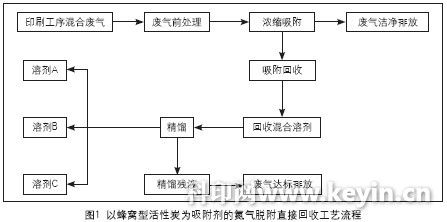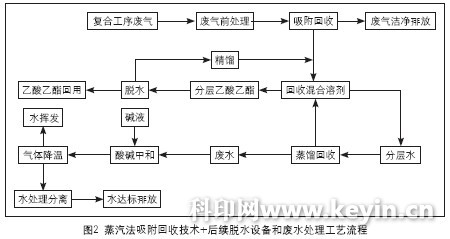BAIDU_CLB_fillSlot("858283");
In view of the high investment cost, poor treatment effect and high operating cost encountered in the organic waste gas treatment in the flexible packaging industry, the industry is also constantly researching countermeasures and optimizing the response plan. Below, respectively, for soft packaging In the printing and compounding process, the treatment method of organic waste gas is optimized, and while considering the treatment effect, energy-saving production and organic solvent recycling are fully considered. Printing process
The main characteristics of the organic waste gas emitted during the printing process are high composition, low concentration and large air volume. Therefore, only low-investment and high-efficiency organic solvent recovery devices can realize the low-cost operation of flexible packaging enterprises. In the past, most flexible packaging enterprises used traditional activated carbon fibers or activated carbon particles for adsorption recovery. Although high purification efficiency can be guaranteed, there are still some limitations. During the treatment, the organic exhaust gas volume is large, plus the adsorbent. The high airflow resistance will result in an increase in fan power consumption; when the organic exhaust gas concentration is low, the recovery rate will become very low. From the perspective of economic efficiency, it is not very ideal, and equipment investment is high, which leads to an increase in operating costs. Furthermore, there are many types of organic waste gas discharged during the printing process, and the recycled matter is a mixed solvent. Generally, it is required to undergo the steps of solvent purification and separation to achieve the recycling requirement, and the purification separation process also requires a large investment, but if the mixing is required, The solvent is sold directly to the purchaser as a waste solvent, and there is also a legal risk of illegal disposal of hazardous waste. In view of the above problems, the direct recovery process of nitrogen desorption using honeycomb activated carbon as an adsorbent (process flow as shown in Fig. 1) can be used to achieve clean production of the printing process. This process combines organic solvent recovery and nitrogen desorption technology to enable the use of miniaturized equipment to treat organic waste gases, and also simplifies the process flow of the treatment process, reducing investment costs and operating costs, while also reducing the operational difficulty of the equipment. When the gas flow rate in the empty column is 1 m/s, the pressure of the honeycomb activated carbon is lowered to about 700 Pa/m, and the pressure of the granular activated carbon is lowered to about 4000 Pa/m. It can be seen that the honeycomb type activated carbon has a small airflow resistance, so it is suitable as an adsorbent material for the treatment of organic waste gas in the printing process, and can achieve the desired effect regardless of economic efficiency or treatment results.

2. Compound process
The organic waste gas emitted in the flexible packaging compounding process is characterized by a single type, a low concentration, and a moderate air volume. In view of this type of emission characteristics, in order to achieve higher solvent recovery rate and organic waste gas emission standards, flexible packaging companies should correctly select a reasonable desorption method. If the hot air method is used for desorption, large-scale equipment is required, and the initial investment is high. In addition, the recovery time by the hot air method is long, which easily causes the hydrolysis of ethyl acetate, so that the alcohol content in the recovered organic solvent is high and there is an odor. If such an organic solvent is reused for production, it will definitely affect product quality. By steam desorption, due to the short recovery time of recycling, the hydrolysis of ethyl acetate can be effectively avoided, but another problem is caused, that is, a large amount of waste water is generated during the condensation recovery process, resulting in an increase in water content in the recovered organic solvent. However, in the flexible packaging compounding process, there is a certain requirement for the water content of the organic solvent, and too high moisture content also affects the product quality.
Comprehensive analysis, you can choose to use steam method to choose steam adsorption adsorption technology + subsequent dewatering equipment and wastewater treatment process (process flow shown in Figure 2), this program can not only help soft packaging enterprises save equipment investment, not only good Solve the problem of organic exhaust emissions and ensure the quality of the recovered solvent. (Editor: Liu Yidong)

The above content is selected from the 12th issue of “ Printing Technology·Packaging and Decoration †of Keyin Media in 2013. For more journal content, please pay attention to the journal channel. The latest journal content clicks into the electronic journal channel of Keyin.com.
Straight Knife Grinding Machine Model innovo-1 is a professional for sharpening variety of angled or straight blade sharpener fa
Straight Knife Grinding Machine Model innovo-1 is a professional for sharpening variety of angled or straight blade sharpener face. It has short grinding time, small amount of grinding, grinding and high precision, knife-edge sharp, reasonable price features.It is ideal for corporate small Printing, packaging, and individual users sharpening equipment
Knife Grinding Machine
Knife Grinding Machine, Blade Grinding Machine
Anhui Innovo Bochen Machinery Manufacturing Co., Ltd. , https://www.innovomachines.com